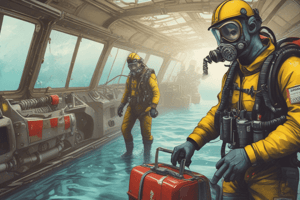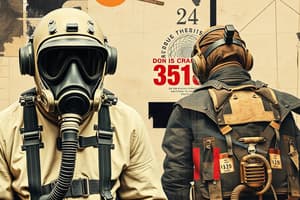Podcast
Questions and Answers
What is the minimum air supply a member can have before entering the Hazard Zone?
What is the minimum air supply a member can have before entering the Hazard Zone?
- 4050 psi (correct)
- 3000 psi
- 3500 psi
- 4000 psi
What does the 'R' in the READY check stand for?
What does the 'R' in the READY check stand for?
- Radio (correct)
- Responsibility
- Regulation
- Readiness
What is the responsibility of individual firefighters regarding air supply?
What is the responsibility of individual firefighters regarding air supply?
- To ensure all crew members have enough air supply at all times.
- To monitor their own air supply and communicate it to the Company Officer. (correct)
- To rely solely on the Division Supervisor for air management.
- To maintain air supply awareness only during emergency situations.
What action must be taken when a firefighter receives a 50% HUD light activation?
What action must be taken when a firefighter receives a 50% HUD light activation?
What should be included in the plan for leaving the hazard zone?
What should be included in the plan for leaving the hazard zone?
Why are adequate 'on-deck' resources important?
Why are adequate 'on-deck' resources important?
What should a crew do if the low air alarm sounds while in the Hazard Zone?
What should a crew do if the low air alarm sounds while in the Hazard Zone?
What does the low air alarm indicate for firefighters?
What does the low air alarm indicate for firefighters?
What is the purpose of the air management system?
What is the purpose of the air management system?
During which phase must the READY check be completed?
During which phase must the READY check be completed?
Which of the following best describes a critical component of air management in operations?
Which of the following best describes a critical component of air management in operations?
What should a company officer do if a member's low air alarm is active?
What should a company officer do if a member's low air alarm is active?
Which component is essential for air supply monitoring during firefighting operations?
Which component is essential for air supply monitoring during firefighting operations?
What percentage of air reserve must firefighters exit the hazard zone with?
What percentage of air reserve must firefighters exit the hazard zone with?
What action is required when the first team member’s 50% HUD light is activated?
What action is required when the first team member’s 50% HUD light is activated?
Who should take the lead in air management during a firefighting operation?
Who should take the lead in air management during a firefighting operation?
What should be done if members hear an active low air alarm in the hazard zone?
What should be done if members hear an active low air alarm in the hazard zone?
What happens if a firefighter exits the hazard zone before their low air alarm activates?
What happens if a firefighter exits the hazard zone before their low air alarm activates?
What should a division supervisor do during a hazard assessment?
What should a division supervisor do during a hazard assessment?
What should happen if crews cannot complete their tasks with the available air supply?
What should happen if crews cannot complete their tasks with the available air supply?
What is a key factor in operating under an offensive strategy for firefighters?
What is a key factor in operating under an offensive strategy for firefighters?
What is the purpose of the emergency reserve air supply in an SCBA?
What is the purpose of the emergency reserve air supply in an SCBA?
What does the Rule of Air Management (ROAM) emphasize?
What does the Rule of Air Management (ROAM) emphasize?
Which of the following best describes a Hazardous Atmosphere?
Which of the following best describes a Hazardous Atmosphere?
How much air supply should firefighters use for working and exiting in a Hazard Zone?
How much air supply should firefighters use for working and exiting in a Hazard Zone?
What is the primary function of the heads-up display (HUD) or pressure gauge in an SCBA?
What is the primary function of the heads-up display (HUD) or pressure gauge in an SCBA?
What should be done if a firefighter's SCBA low air alarm activates?
What should be done if a firefighter's SCBA low air alarm activates?
Which of the following strategies contributes to safe air management?
Which of the following strategies contributes to safe air management?
What is essential for each individual to follow during air management?
What is essential for each individual to follow during air management?
Flashcards are hidden until you start studying
Study Notes
Air Management
- Purpose: This is a standard operating guideline (SOG) that provides definitions, strategies, and general information for safe air management while operating in or near a hazardous atmosphere requiring the use of self-contained breathing apparatus (SCBA).
- Scope: This applies to all members participating in emergency incidents or training exercises where SCBA is required. The last 33% of the air supply in an SCBA is the emergency reserve, and the initial 66% of the air supply is for working and exiting the hazard zone.
- Definitions:
- Air Management: Ongoing assessment of air consumption by firefighters and/or teams who are breathing air from their SCBA. Firefighters must continually check their SCBA gauge to know how much air remains.
- Rule of Air Management (ROAM): Follow three key steps: 1) know how much air has been used, 2) Manage the amount of air left in your SCBA, and 3) exit the hazard zone before your SCBA low air alarm activates.
- Hazardous Atmosphere: An atmosphere that is oxygen deficient or contains toxic and/or disease-producing contaminants. These atmospheres can be Immediately Dangerous to Life or Health (IDLH), also known as the Hazard Zone.
- Immediately Dangerous to Life and Health (IDLH): An atmosphere that poses an immediate threat to life or health.
Air Management Standard
- READY Check: Each team member must complete a READY check before entering an IDLH environment. This check ensures the following:
- Radio: Each member must have a radio and ensure it is on and tuned to the correct channel.
- Equipment: Each member must have the correct equipment for the given assignment.
- Air: No member can enter the hazard zone with less than 40 psi of air.
- Duties: Each member needs to understand their assignment and the plan for completing the task, including the what, when, where, and how of their assignment.
- Yes: Each member must confirm "Yes" to all the above questions.
Air Management Procedures
- Monitoring air supply: Monitoring one’s air supply is a learned skill that should be practiced regularly and becomes muscle memory. It is also important to follow standardized work cycles during firefighting operations.
- Low Air Alarm: No one should leave the hazard zone with their SCBA low air alarm activated. If a low air alarm sounds, the crew needs to communicate Priority Traffic to the IC or D/G Supervisor and provide a CAN report.
- 50% HUD Light Activation: When the first member of the company or crew gets a 50% HUD light activation, the member must notify their supervisor.
- Low Air Alarm in the Hazard Zone: If a low air alarm is activated in the hazard zone, the officer/team leader must immediately alert their D/G Supervisor. The officer/team leader needs to provide their unit ID, declare Priority Traffic, the location of the crew, and an estimation of how close they are to the exit. An example of a radio transmission is: "E 33 Priority Traffic: We have FF Smith with a low-air alarm active. We are 75 feet into the building. We will advise when we exit."
- Two-Cylinder Rotation: If a firefighter exits the hazard zone prior to their low air alarm activating, they may replace the SCBA bottle and return to the hazard zone. This creates a two-cylinder rotation for firefighters. After the second round of cylinders, the firefighter MUST go to rehab.
- Mayday: If members hear an active low air alarm in the hazard zone, and there is no immediate radio report from the team, it should be treated with the same urgency as a Mayday.
- Strategic Level Air Management: This is the most dangerous position for firefighters. Air management must be a priority, and firefighters must be able to exit the hazard zone with at least 33% air remaining. If crews are unable to complete their assigned task with that air supply, the IC must provide an adequate number of companies to replace them or change the strategy to defensive.
- Division Supervisor Level Air Management: Division supervisors must assess hazards and implement the standard decision-making model within their portion of the incident, ensuring that crews operate safely and have a clear exit plan.
- Task Level Air Management: Individual firefighters are responsible for monitoring their air supply and communicating this with the company officer. The best plan is to leave the hazard zone following the hose line you came in on, which includes normal operations as well as emergency situations.
Studying That Suits You
Use AI to generate personalized quizzes and flashcards to suit your learning preferences.




